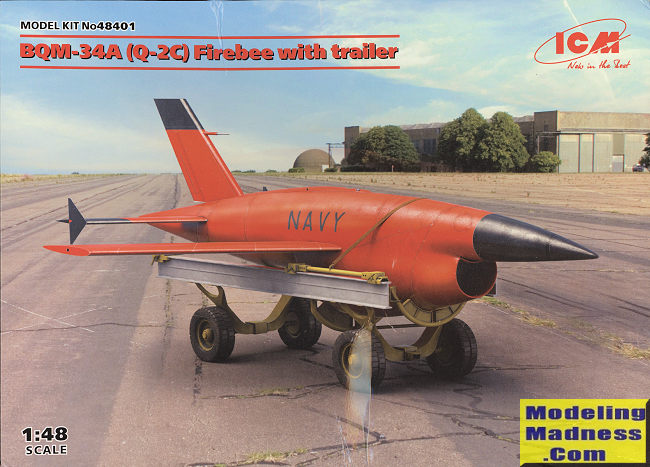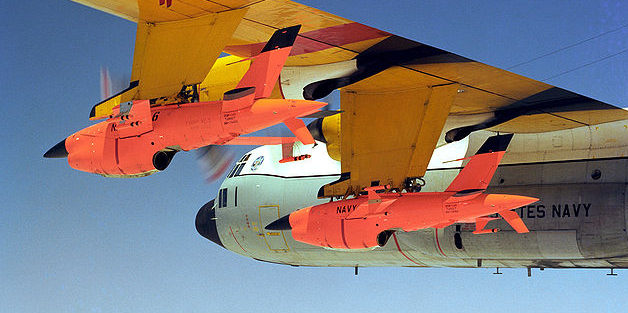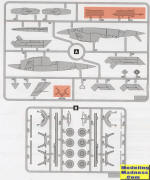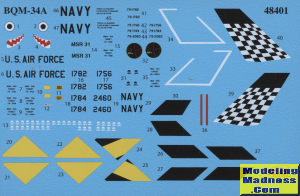
ICM 1/48 BQM-34A Firebee
| KIT #: | 48401 |
| PRICE: | $ |
| DECALS: | Four options |
| REVIEWER: | Scott Van Aken |
| NOTES: | New tool. Includes trailer |

| HISTORY |
In the late 1950s, the USAF awarded Ryan a contract for a substantially improved "second generation" Firebee, the Model 124, originally with the designation Q-2C. The initial prototype performed its first flight in late 1958 and went into production in 1960. In 1963, it was redesignated the BQM-34A. The old first-generation KDA-1 and KDA-4 targets then still flying with the Navy were (somewhat confusingly) given the respective redesignations AQM-34B and AQM-34C.
The BQM-34A emerged as the Firebee as it is recognized today, with a bigger airframe, longer wings, and a particular "chin"-type inlet under a pointed nose (in contrast to the circular intake of the first-generation Firebees). It was powered by a Continental J69-T-29A turbojet, a copy of the improved Turbomeca Gourdon derivative of the Marbore, with 1,700 lbf (7.6 kN) thrust. The U.S. Navy also adopted the BQM-34A, while the Army obtained a ground-launched version designated MQM-34D with longer wings and a heavier JATO booster.
A feature of the second-generation Firebee is that some photographs show it to with triangular endplates on the tailplane, while others show no endplates but feature a ventral fin under the tail, and still others have neither endplates nor ventral fin. Since most modern photographs of Firebees show the ventral fin, this may have been due to production changes or later refits (reference sources are unclear on this).
In 1960 the first stealth technology development program was initiated by USAF, by reducing the radar cross-section of a Q-2C drone. This was achieved through specially designed screens over the air intake, radiation-absorbent material on the fuselage and a special radar-absorbing paint.
Meanwhile, the U.S. Navy upgraded the avionics in their BQM-34As, which were then designated BQM-34S. In the early 1980s the Navy also began to refit these with the uprated J69-T-41A engine of 1,920 lbf (8.5 kN) thrust. The Air Force began to update their BQM-34As with improved avionics and also the J85-GE-7 engine which was fitted without major changes in the drone's airframe; the improved USAF variants retained their existing BQM-34A designation.
BQM-34A production ended in 1982, but the production line was reopened in 1986 to produce more BQM-34S targets. Air Force and Navy Firebees have received further upgrades since that time, most refitted beginning in 1989 with the improved J85-GE-100 engine (also with 2,450 lbf (10.9 kN) thrust) as well as modernized avionics. In the late 1990s some Firebees were also fitted with GPS navigation receivers.
 The Firebee's main air launch platform is the Lockheed DC-130 drone controller aircraft, which can carry four drones on underwing pylons. The Firebee is typically snatched out of the air by a recovery aircraft that sweeps up the drone's parachute, simplifying recovery and reducing damage to the target from ground impact. During early test flights, the Fairchild C-119 was used for this purpose, while on operational flights the Sikorsky SH-3 Sea King was the primary recovery platform. The drone can float for an extended period of time if it ditches in water.
The Firebee's main air launch platform is the Lockheed DC-130 drone controller aircraft, which can carry four drones on underwing pylons. The Firebee is typically snatched out of the air by a recovery aircraft that sweeps up the drone's parachute, simplifying recovery and reducing damage to the target from ground impact. During early test flights, the Fairchild C-119 was used for this purpose, while on operational flights the Sikorsky SH-3 Sea King was the primary recovery platform. The drone can float for an extended period of time if it ditches in water.
The target drone can be fitted with various control systems, some that give it fighter-like maneuverability. It is also equipped with scoring and countermeasures systems, radar enhancement devices to allow it to emulate a wide range of combat aircraft, and wingtip thermal flares which cause heat-seeking missiles to aim for wing tips rather than the engine exhaust, sparing the target. It can also tow a target sleeve or other types of towed targets.
| THE KIT |
 It
is neat that ICM has decided to kit these aircraft. Something that seems to be
the norm now from central/eastern Europe kit makers is a box that has a flimsy
top with a more sturdy cardboard flip top box. As with all current ICM kits, the
external detailing is excellent. There are two sprues; one is the aircraft and
the other is the handling trailer. There are some unused parts, these being wing
pylons not used with this boxing.
It
is neat that ICM has decided to kit these aircraft. Something that seems to be
the norm now from central/eastern Europe kit makers is a box that has a flimsy
top with a more sturdy cardboard flip top box. As with all current ICM kits, the
external detailing is excellent. There are two sprues; one is the aircraft and
the other is the handling trailer. There are some unused parts, these being wing
pylons not used with this boxing.
There really is not all that much to the airframe with construction
only taking six of the fifteen construction steps. The rest, of course, are for
the trailer. You are provided a complete intake, though dealing with the seam
will be a challenge. You can install the tailplane plates if you wish and half
the markings options will require these. One of the options does not have the
small ventral fin and you'll need to remove that one.

The trailer is what consumes most of the construction steps and is a model in and of itself. Three of the four options are what is listed as 'deep red'. It is actually da-glo, though I have seen these painted international orange. As you can see from the included photo, the main shade is the da-glo. There are three Navy and one Air Force aircraft. One of the Navy options is mainly white. All paint references are in ICM paint references. The decals are very nicely done so should provide no issues.
| CONCLUSIONS |
This is a neat kit. It won't be all that difficult to build, but I have to admit that painting da-glo requires some skills. It will make an interesting change in pace from whatever it is you usually build.
| REFERENCES |
https://en.wikipedia.org/wiki/Ryan_Firebee
May 2021
Copyright ModelingMadness.com. All rights reserved. No reproduction without express permission.
If you would like your product reviewed fairly and fairly quickly, please contact the editor or see other details in the Note to Contributors.